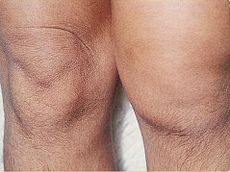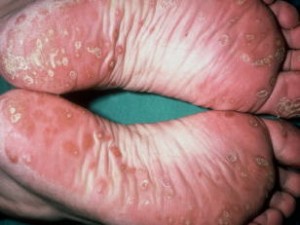Are you suffering from swollen joints, skin sores and/or inflammation of the eyes? If you are, the problem could be Reactive arthritis. Get detailed information about the causes, symptoms, diagnosis, treatment options and more of this disease.
Reactive arthritis Definition
Page Contents
- 1 Reactive arthritis Definition
- 2 Reactive arthritis ICD9 Code
- 3 Reactive arthritis Incidence
- 4 Reactive arthritis Symptoms
- 5 Reactive arthritis Causes
- 6 Is Reactive arthritis Contagious?
- 7 Reactive arthritis Risk Factors
- 8 Reactive arthritis Diagnosis
- 9 Reactive arthritis Differential Diagnosis
- 10 Reactive arthritis Treatment
- 11 Reactive arthritis in Children
- 12 Post-streptococcal Reactive arthritis
- 13 Reactive arthritis Prognosis
- 14 Reactive arthritis Complications
- 15 Reactive arthritis Prevention
- 16 Reactive arthritis Pictures
It is a type of autoimmune condition that may affect the eyes, the urethra and the joints, leading to the inflammation of these regions. This is actually a group of conditions clustered together and arises in response to some infection.
The disease is also known by other names like:
- Reiter Syndrome
- Post-infectious arthritis
However, Reiter Syndrome is actually a particular form of Reactive arthritis.
Reactive arthritis ICD9 Code
The ICD9 code for this disorder is 099.3.
Reactive arthritis Incidence
This is a rare disease and generally affects around 5 out of 100,000 individuals in the 18-60 age group. The condition is rare in young kids although it may arise in teenagers.
Reactive arthritis Symptoms
Individuals affected by this condition usually exhibit signs and symptoms 1-3 weeks after being exposed to a trigger factor of the infection responsible for its occurrence. The symptoms include:
Musculoskeletal problems
These are experienced in the muscles and bones and may include:
- Heel pain
- Pain in joints, especially in the ankles, knees and feet
- Pain and inflammation at the back of the ankle
- Inflammation in the fingers or toes, which makes them appear as sausages
- Pain in the buttocks or lower back
Urinary and reproductive problems
The possible signs of the problem manifested in the urinary and reproductive systems may involve:
- Increased urinary frequency
- Pain or burning sensation while passing urine
- Swelling of the cervix (Cervicitis)
- Swelling of the prostate gland (Prostatitis)
- Leakage of fluid from the urethra
- Problems in starting or continuing urination
Problems in eyes, skin and mouth
These include:
- Swelling of the eye (Conjunctivitis)
- Ulcers in the mouth, tongue and penis
- Skin rashes or soles on the soles or palms, which may look similar to Psoriasis
- Swelling of the inner eye (Uveitis)
- Low fever, along with discharge from the eye, ocular redness or burning sensation that can develop in the later weeks
Reactive arthritis Causes
The condition, as aforementioned, arises as a response to an infection developing in some other region of the body – frequently the urinary tract, genitals or intestines. Patients may not know about the triggering infection as it may give rise to mild or no symptoms at all.
A number of bacteria may be responsible for the development of this disorder, the most common of which include:
- Shigella
- Chlamydia
- Campylobacter
- Salmonella
- Yersinia
A hereditary association has also been suspected and a few genes are supposed to increase the risk of developing this condition.
Is Reactive arthritis Contagious?
No. This is a non-contagious disorder although the bacteria that are responsible for its occurrence can be sexually transmitted or spread through intake of contaminated food. However, only a few individuals who are exposed to these bacteria may develop the disorder.
Reactive arthritis Risk Factors
The possible risk factors for this disease include:
Sex
The condition is most common in males aged between 20 and 40 years. Although women may also develop this disease, they generally exhibit more moderate symptoms. Both males and females are at equal risk of developing Reactive arthritis as a response to food-borne infections. However, males are at greater risk of developing the disorder due to bacteria that are sexually transmitted.
Genetics
The condition may have a hereditary association as many individuals affected by this disease have a type of molecule on the cellular surface that can be genetically inherited. However, one does not surely develop the disease due to the presence of this genetic marker, known as the Human Leukocyte Antigen B27 (HLA-B27) although it can elevate the risk of development of the disorder in case of exposure to a particular bacteria.
Reactive arthritis Diagnosis
The diagnosis of this disorder is based on the clinical signs exhibited by patients. The diagnosis may get delayed as the symptoms may arise at different times. A physical exam may reveal skin sores or symptoms of conjunctivitis. During physical tests, physicians may check the following:
- Whether rashes have developed over the skin
- Whether the eyes have got swollen
- The range of motion in the joints that have been affected
Additional tests that might be required for the detection of this condition include:
- Joint x-rays
- HLA-B27 antigen
- C-reactive protein
- Urinalysis
- Sed rate (ESR)
Blood tests
Analysis of blood samples may help reveal the following problems:
Inflammation
Blood tests may show an elevated sedimentation rate, the pace at which the red blood cells (RBCs) settle to the bottom of a tube. An increased rate can suggest swelling. Those suffering from Reactive arthritis are often detected with an elevated sedimentation rate.
Infections
In some cases, the bacteria that are responsible for the development of this disease can still be detected in the blood of affected individuals. In many cases, however, the symptoms arise long after patients recover from the infection.
Genetic markers
The risk of development of Reactive arthritis is increased due to the genetic acquiring of the HLA-B27 antigen. However, the disorder may also arise in patients without the antigen.
Evidence of other medical issues
The antibody called Rheumatoid factor is frequently detected in the bloodstream of Rheumatoid arthritis patients. The proteins known as anti-nuclear antibodies are usually found in individuals with autoimmune or connective tissue disorders.
Joint fluid tests
Physicians may use a needle to extract a fluid sample from within a joint that has been impacted. The fluid is analyzed for:
Crystals
Patients are suspected to have gout in case of presence of uric acid crystals in the fluid. Gout patients often suffer from acute pain in their big toe.
Infections
Although Reactive arthritis is triggered by an infection in some other area of the body, the infection does not affect other joints. Patients are suspected of having Septic arthritis, which can lead to acute joint damage, if the joint fluid is found to be infected.
Imaging tests
Joint x-rays can reveal any of the characteristic symptoms of reactive arthritis, such as cartilage damage, soft tissue inflammation or deposition of calcium in the point of attachment of the tendons to the bones. X-ray imaging exams can also help rule out the presence of other forms of arthritis.
Other body fluid examinations
Physicians may also analyze other body fluids, such as throat mucus, urine or genital secretions of patients to check for infections. In some cases, stool samples may also be analyzed.
Reactive arthritis Differential Diagnosis
The differential diagnosis for this type of arthritis involves ensuring that the symptoms experienced by patients are not the result of any of the following disorders:
- Rheumatoid arthritis
- Septic arthritis
- Psoriatic arthritis
- Rheumatic fever
- Gonococcal arthritis
- Gout
- Inflammatory bowel disease
- Ankylosing spondylitis and undifferentiated spondyloarthropathy
Reactive arthritis Treatment
The aim of treatment is to alleviate the symptoms and cure the infection responsible for this disorder. The skin sores and eye problems usually do not need any treatment and the issues resolve on their own.
In case of an infection, physicians are likely to prescribe patients with antibiotic medications. Pain-relievers and Non-steroidal anti-inflammatory drugs (NSAIDs) may be administered for relieving joint pain. If the joint inflammation is acute and persists for an extended duration, a strong anti-inflammatory corticosteroid may be injected into the affected region.
Physical therapy may help relieve painful sensation, maintain muscular strength and help in better movement of the affected joint. Patients engaged in jobs that demand heavy lifting or putting excessive stress on the back may need to make changes or even change their profession. Those with an acute case of the condition may require immune-suppresive therapy. However, this curative measure is not implemented quite often.
Reactive arthritis in Children
The symptoms of the disorder are often apparent after an intestinal infection by a bacterium that is responsible for food poisoning. Most children, as well as women, are found to develop an intestinal form of Reactive arthritis.
Post-streptococcal Reactive arthritis
The term “Post-streptococcal Reactive arthritis” was originally applied to children who exhibited the symptoms of Reactive arthritis. The distinguishing features of this disease, as proposed by medical practitioners, included:
- Onset within 10 days of being infected by Group A streptococcus
- Recurrent or Prolonged Arthritis
- Poor improvement of symptoms after aspirin administration
- Typically non-migratory symptoms of Arthritis
Reactive arthritis Prognosis
The condition may resolve in a few weeks, but may also persist for a few months in some cases. Its signs may recur over a period of several years in up to half of all sufferers. In rare cases, patients may be detected with issues in the aortic heart valve or an abnormal cardiac rhythm. In most people, the signs of the disorder generally come and go and eventually resolve within a span of a year.
Reactive arthritis Complications
The problems arising due to this disorder may persist for anywhere between 3-12 months. However, many sufferers can manage these difficulties with symptomatic treatment and return to normalcy within 2-6 months following the onset of the disease.
Up to half of all Reactive arthritis sufferers have a recurrence of the symptoms after the resolution of the initial condition. The recurrences are supposed to be a result of re-infection. Back pain and arthritis are some symptoms that recur most often although eye inflammation and urogenital swelling are also found to recur.
Reactive arthritis Prevention
The disease can be prevented by adapting the following measures:
- Practicing safe sex, to prevent STDs and lowering the risk of Reactive arthritis
- Avoiding infections while eating, cooking or storing food
- Cooking foods properly
- Storing foods at right temperatures
However, genetic factors that are responsible for this syndrome cannot be prevented. This is due to the reason that the genetic makeup cannot be changed.
Reactive arthritis Pictures
Take a look at these assistive images to know how Reactive arthritis affects the physical appearance of its sufferers.
Picture 1 – Reactive arthritis
Picture 2 – Reactive arthritis Image
If you or any of your friends or family members is exhibiting the symptoms of Reactive arthritis, consult a physician immediately. Faster medical attention and treatment can address the disorder in its initial stages and prevent the worsening of its signs.
References:
http://www.mayoclinic.com/health/reactive-arthritis/DS00486
http://en.wikipedia.org/wiki/Reactive_arthritis
http://www.ncbi.nlm.nih.gov/pubmedhealth/PMH0001476/
http://www.patient.co.uk/doctor/Reactive-Arthritis.htm
http://emedicine.medscape.com/article/331347-overview


